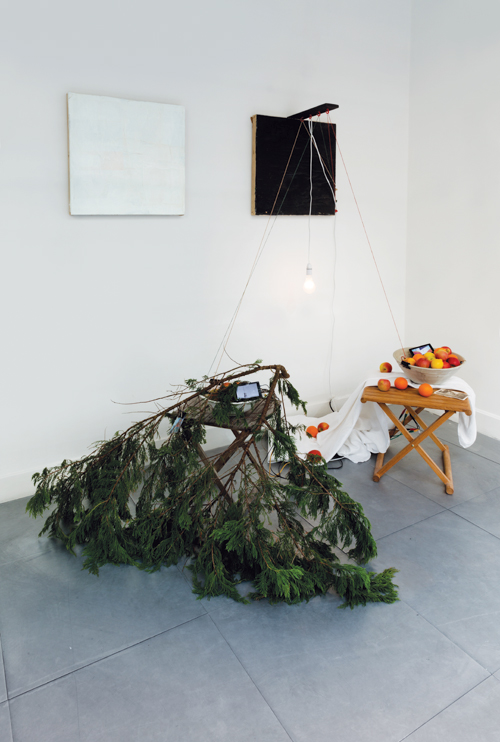Malcolm Le Grice
Richard Saltoun, London, UK
Richard Saltoun, London, UK

Like many others of his generation, Malcolm Le Grice loaned out, rather than sold, work through the London Filmmakers’ Co-operative. His first solo exhibition in a commercial gallery therefore gave rise to interesting questions about the display, distribution and ultimate displacement of such work. While the exhibition’s playful title – ‘No Idea’ – might have inadvertently reflected the gallery’s unwillingness to engage with such issues when I raised them, Le Grice explained that it was, in fact, intended to emphasize the conditional link between his intuitive approach to filmmaking and his considerable scholarly output as a film historian and theorist.
‘No Idea’ also arose, Le Grice told me, as a reaction against bon mot conceptualism, where the reach of meaning hangs off a one-line gag. I wonder whether he had in mind, as I did, Martin Creed’s Work No. 227 The Lights Going On and Off (2000) – the Turner Prize-winning piece in which a hanging light bulb goes on and off every five seconds in a room. You needn’t have read Nicky Hamlyn’s Film Art Phenomena (2003) to understand Creed’s debt to Le Grice’s Castle (1964/2015) and Castle 1 (1966), found footage of imperial technologies of expansion whited-out by a flashing bulb in front of the screen.
At Saltoun, Castle was prominently, sensationally, coaxingly installed in the gallery window. A flashing bulb dangled from a hooked Rauschenbergian appendage fixed above a square canvas, its papier-mâché layered surface painted pitch black. To its left hung the painting’s negative, a similarly layered void, this time painted white. Binary poles of on/off, like the bulb’s flash, the black and white diptych presides over a still-life arrangement of doubled-up objects: a string from the black painting’s protrusion is bound to two fruit bowls filled with spherical fruit and miniature LCD screens placed on two found wooden tables. Mixed with formally homonymic objects, such as tennis balls and lightbulbs, the fruit spills from each bowl (the sweet must of slow decay an olfactory register of temporality). One screen displays a real-time feed of the dangling bulb from the perspective of a camera hidden inside one of the bowls; the other displays Castle 1, proposing a looping yet open sense of time.
By the late 1960s, Le Grice was beginning to move freely between – and often combining – paint and printed matter, film, computer art, video and digital media which, parsed in ‘No Idea’, express a radical desire to move beyond specific media in a cybernetic age. (Le Grice had membership number 008 of the Computer Art Society, which also included Gustav Metzger and its co-founder John Lansdown.) In some way, Le Grice’s canvases are an anticipation of what we might now call ‘post-digital’ painting.
Though Berlin Horse (1970/2015), Le Grice’s most famous work, felt somewhat marginal here, represented in a 4 × 4 grid of pigment prints, and computer moving-image work was absent, we were made acutely aware of post-production and the constructive loss of the filmic event itself. After-, Under- and Behind Leonardo (all 1984), a triptych collage of tape and Xeroxed fragments of Leonardo’s Mona Lisa (c.1503 17), blankly faced a vitrine containing After Leonardo/Behind Leonardo (1984), the recto/verso of a 1950s magazine reproduction of Mona Lisa and Lucas Cranach the Elder’s Venus Standing in a Landscape (1529), pinned above a dismantled copy of Freud’s infamous study of a young Leonardo. From behind, a layered six-screen video scrutinizing the surface of the Mona Lisa was projected into the corner of the room, casting a vitrine-shaped shadow across distorted images. (In the post-war history of the Mona Lisa, Sturtevant appropriated Duchamp’s appropriation, Warhol multiplied it and Le Grice made it multi-media.)
Le Grice’s experiment with media is perhaps another reason he’s fallen between institutional remits. While Tate controversially purchased Creed’s Work No. 227 for the nation, there’s not a single piece by Le Grice in their collection. Arguably, the ‘expanded cinema’ work of Le Grice, and others of his generation, opened the way for younger British artists working in performance and video to exhibit and be collected by institutions.
Commercial galleries can play an important role in ‘rediscovering’ and exhibiting the estates of artists whose careers have typically been antagonistic to the commodity form and are often a vital conduit for getting such work into mainstream institutions. Nevertheless, there are certain perils. While the rental structure of the Filmakers’ Co-op is a reason why Le Grice’s work is not in collections, as soon as the work enters commercial galleries, the ‘we’ of co-operative risks being subordinated to the ‘I’ of private property. (Jo Spence is another of Saltoun’s ‘rediscoveries’: I’ll never forget seeing her laminated collages in the gallery; at the bottom right was a postal address to write to if you wanted to exhibit them in your local community centre or women’s group.) The museum is an urgent setting for works like these, ensuring access, scholarship and guardianship. Institutions need to wise up.






















